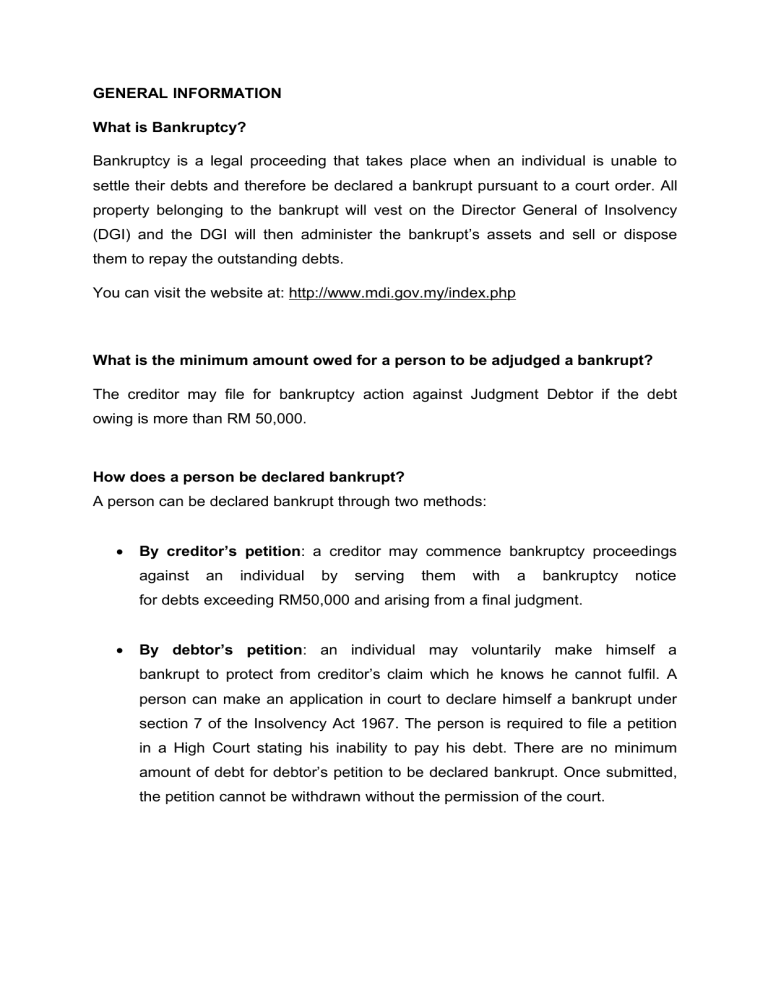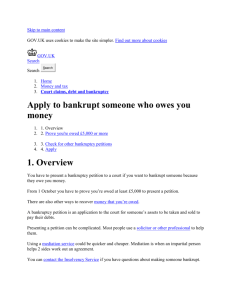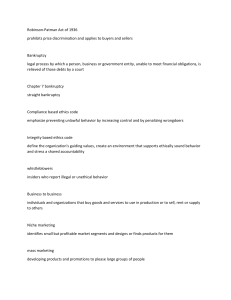
GENERAL INFORMATION What is Bankruptcy? Bankruptcy is a legal proceeding that takes place when an individual is unable to settle their debts and therefore be declared a bankrupt pursuant to a court order. All property belonging to the bankrupt will vest on the Director General of Insolvency (DGI) and the DGI will then administer the bankrupt’s assets and sell or dispose them to repay the outstanding debts. You can visit the website at: http://www.mdi.gov.my/index.php What is the minimum amount owed for a person to be adjudged a bankrupt? The creditor may file for bankruptcy action against Judgment Debtor if the debt owing is more than RM 50,000. How does a person be declared bankrupt? A person can be declared bankrupt through two methods: By creditor’s petition: a creditor may commence bankruptcy proceedings against an individual by serving them with a bankruptcy notice for debts exceeding RM50,000 and arising from a final judgment. By debtor’s petition: an individual may voluntarily make himself a bankrupt to protect from creditor’s claim which he knows he cannot fulfil. A person can make an application in court to declare himself a bankrupt under section 7 of the Insolvency Act 1967. The person is required to file a petition in a High Court stating his inability to pay his debt. There are no minimum amount of debt for debtor’s petition to be declared bankrupt. Once submitted, the petition cannot be withdrawn without the permission of the court. Do you know that you can be declared bankrupt without your knowledge? A person can be declared a bankrupt without their knowledge as per below: Before a person can be adjudged a bankrupt, he will have to be personally served with the relevant legal documents. However, sometimes he will not receive these court papers due to various reasons (eg: the court documents are sent to his old address). Bankruptcy was served by a substituted service procedure. (This means the court papers will be advertised in the newspaper (among other things) and it will be deemed as if the person received the court papers personally.) Does not turn up to court. Does not accept or open any legal documents sent. How to check my Bankruptcy Status? You can conduct a bankruptcy search to check your status at Malaysia’s Department of Insolvency’s headquarters in Putrajaya for a fee of RM10 via cash. You can also use MyEG’s services to check your bankruptcy status. A fee of RM12 will be charged per name per bankruptcy search. Apart from that, you can also make a request for your credit report from Malaysia’s Credit Bureau (CCRIS) Please refer to the website: https://www.myeg.com.my/services/insolvensi Please refer to the website: http://creditbureau.bnm.gov.my/ Where to get help if I think I may be declared Bankrupt? Get free Professional Help from Credit Counselling and Debt Management Agency (AKPK) - If you are having problems managing your debts and making repayments for your loans, you can seek help from the Credit Counselling and Debt Management Agency (AKPK). AKPK was set up by Bank Negara Malaysia and provides their services for free. The services they provide are financial counselling and advice, debt management programme and financial education programs. Kindly refer to their website: https://www.akpk.org.my/ Discuss with your creditors - You can renegotiate with the bank if you are unable to make repayments for your loans. Most banks are open to renegotiate the terms of loans as banks would also want to minimize the tendency of a non performing loan. - Have a discussion with the bank and work out a repayment arrangement which you can afford and the banks are agreeable upon. You can approach AKPK to be the mediator through their debt management program if you find problems negotiating with your bank. What Are The Procedures Of Bankruptcy? (a) Bankruptcy Notice (BN) Stage Generally speaking a person can only be made a bankrupt if they have first committed an act of bankruptcy. There are different types of acts of bankruptcy, but the most common is a situation where a person has a final judgment ordered against him and he fails to comply with a bankruptcy notice requiring him to settle the judgment. (The bankruptcy notice is a demand for the debtor to pay the debt within 7 days from service of the bankruptcy notice). BN is valid for 3 months. The creditor serves the BN via Personal Service and this has to be proved by Affidavit of Service. If the creditor unable to serve the BN via Personal Service, he may apply to the court for Substituted Service. (b) Creditor’s Petition (CP) Stage If the debtor does not settle the payment the specified timeframe, he would then be said to commit an act of bankruptcy. Following an act of bankruptcy, a creditor petition may be presented to the court. If the court grants the petition, they will grant a Bankruptcy Order which means the debtor is officially adjudged a bankrupt and this empower the Director General of Insolvency to take over the property and assets of the bankrupt. What should I do to appeal against the Bankruptcy Order? If you are aggrieved by the decision made against you, you can appeal against the Bankruptcy Order [section 92 of the Insolvency Act 1967]. The procedure is as follows: (i) File Notice of Appeal in the Form 114 through E-filling within fourteen days from the date of decision of the Registrar. (ii) The sealed copy of the notice must be served on all other concerned parties not less than five days before the date fixed for the hearing of appeal. What should I do once I am a Bankrupt? Once a person has been adjudged bankrupt by the court, he must attend to MdI's branch that administers his bankruptcy case. Once he attends the branch, he will be required under the insolvency law to provide his details in a preliminary enquiries session, among others his full name, identification number, residential address, details on family members and causes of his bankruptcy. The bankrupt will also be required to file in Statement of Affairs which needs him to disclose his assets and liabilities to the DGI. What are the responsibilities of a Bankrupt? Bankrupt's responsibilities include: Attending at the DGI's office as soon as possible upon the making of the Bankruptcy Order and other subsequent meetings with the DGI whenever notified; Handing over all assets to the DGI; Submitting a completed Statement of Affairs; Submitting an Income and Expenditure Statements every six (6) months; Attending all meetings of creditors; Making contribution / payments towards bankruptcy estate out of personal income; Refrain from obtaining further credit; Shall not to obtain a credit of RM1,000.00 or more from any person without informing the creditor his status as a bankrupt; Not to make payments direct to the creditors; Informing the DGI immediately of all changes of name, address, telephone number, income, property and other relevant information; Responding to the DGI's inquiries within a stipulated time; and Complying with DGI's, Court orders and provisions in the Insolvency Act 1967. What are the ways out of the bankruptcy? You either pay-off your debts or wait 3 years for an automatic discharge from bankruptcy. Once discharged, you will also be released from your unpaid balance debt. However, this excludes debts owed to the government or anything obtained through illegal activity. There are three different ways of becoming “unbankrupt” Annulment: Your bankruptcy records are expunged after paying off your debts in full. Discharged: You are no longer bankrupt with negotiation with creditors on repayments. However, your records remain in CCRIS, CTOS, and other credit rating agencies. Automatic discharge for a bankrupt by DGI You can immediately apply for passport and bank accounts again. What is Automatic discharge for a bankrupt? Automatic discharge is only subject to the prerequisites as stipulated by the Act as follows: (a) Bankruptcy notice (BN) issued only on and after 6 October 2017; (b) Has already filed and submitted the statement of affairs under section 16 of Act 360; (c) Has filled out an application form and undertaking to comply with the target contribution and to file an account of moneys and property every six months; (d) The duration for monitoring of the target contribution of three years starts from the date the statement of affairs is filed; and (e) The bankrupt has achieved the target contribution as determined by the DGI taking into account some of the matters set forth in the Act. Note: Any bankrupt who fails to complete the contribution target (TC) within three years as set forth, therefore such bankrupt is not eligible for automatic discharge and the case will be administered as usual until a further situation can be decided later by MDI.


